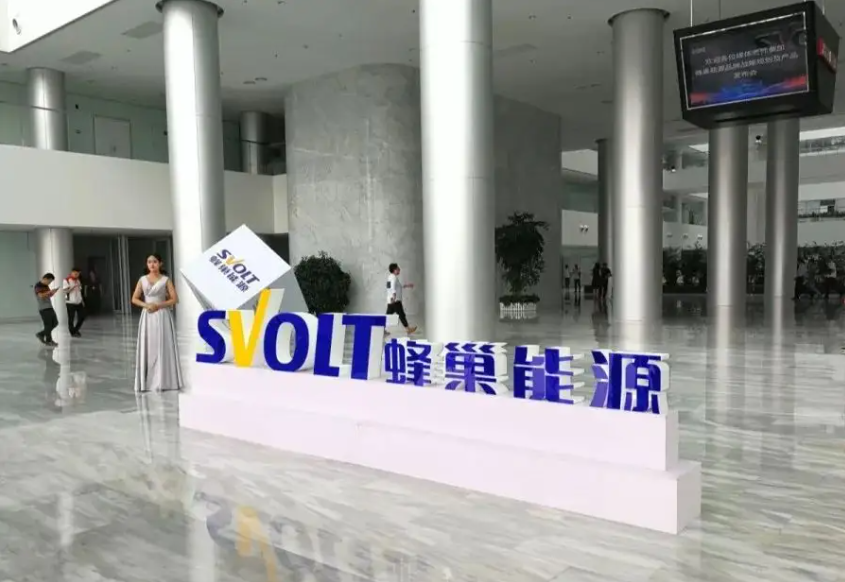| Author | Lingfang Wang |
|---|---|
| Editor | Kaijun Qiu |
Honeycomb Energy has finally submitted an IPO application.
On November 18th, the official website of the Shanghai Stock Exchange disclosed that Honeycomb Energy Technology Co., Ltd. had received acceptance for its IPO on the Science and Technology Innovation Board. “According to the prospectus, Honeycomb Energy plans to raise CNY 15 billion in funds, with a valuation of CNY 60 billion, ranking among the unicorn companies in new energy.”
This is the second power battery company headquartered in Changzhou to conduct an IPO. The other one, which was listed on the Hong Kong Stock Exchange not long ago, is Contemporary Amperex Technology Co. Ltd. (CATL), with an estimated market value of CNY 63 billion.
“Both companies are located in Changzhou, and their valuations have reached CNY 60 billion in the growth stage. The difference is that CATL is a relatively long-established old company, while Honeycomb Energy is a new force in the battery industry.”
Another thing they have in common is that they are both “descendants” of Contemporary Amperex Technology Co. Ltd. (CATL). As an industry benchmark, it is necessary for Honeycomb Energy and CATL, IPO new stars, to make a comparison and see how much they are worth investing in.
Basic Information
According to SNE Research, a lithium battery market research organization in South Korea, Honeycomb Energy was ranked 10th in terms of power battery installation in 2021 and the first half of 2022; according to the China Automotive Power Battery Industry Innovation Alliance, Honeycomb Energy was ranked 6th in terms of power battery installation in China in 2021 and the first half of 2022.
“Honeycomb Energy is headquartered in Changzhou, Jiangsu Province, and has built production bases in Changzhou, Baoding, Taizhou, Nanjing, and Ma’anshan. It has established research and development bases in Baoding, Shanghai, Wuxi and other places.”
Honeycomb Energy was born out of Great Wall Motor Company and has a close relationship with Great Wall Motor Co., Ltd. and its chairman Wei Jianjun.
Currently, the controlling shareholder of Honeycomb Energy is Baoding Ruimao, which holds 39.4% of shares and 76.47% of voting rights. “Through Baoding Ruimao and Great Wall Holdings, Wei Jianjun controls 40.26% of Honeycomb Energy’s equity and 76.81% of its voting rights, making him the actual controller of the company.”
The other two shareholders holding more than 5% of the shares are Advanced Manufacturing Fund and Beijing-Tianjin-Hebei Fund, and it should be noted that the executive partners of both funds are China Merchants Group, which jointly holds 10.82% of Honeycomb Energy’s shares.
When it comes to the operating situation, as expected, Hunan Corun New Energy, which is currently in the stage of capacity climbing, is still in a loss-making state. The company suffered losses of 896 million yuan in the first half of 2022, and losses of 326 million yuan, 701 million yuan, and 1.15 billion yuan in 2019-2021, respectively.
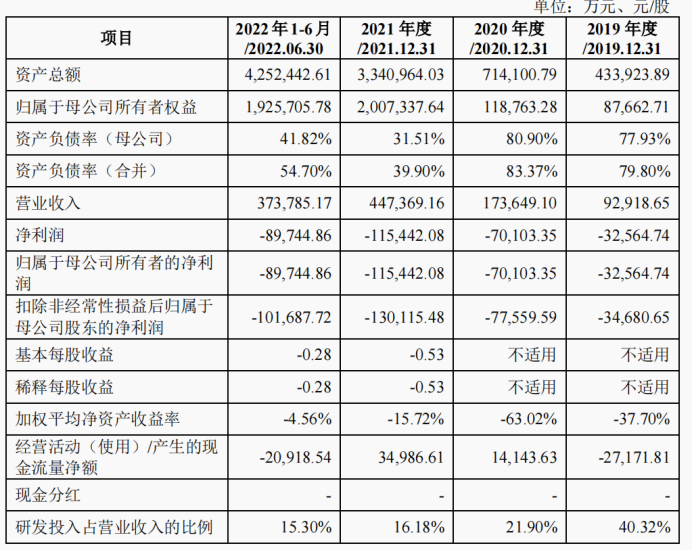
Revenue and Gross Margin
In the first half of 2022, Hunan Corun New Energy’s operating income was 3.738 billion yuan.
Zhongchuang Xinhang did not publish a semi-annual report, but the information disclosed after their hearing gathering shows that their revenue and gross margin in the first half of the year were much higher than that of Hunan Corun New Energy, reaching 9.167 billion yuan.
Of course, this revenue of tens of billions is far from that of Contemporary Amperex Technology Co. Limited (CATL). In the first half of 2022, CATL’s revenue exceeded 110 billion yuan, approaching the full-year revenue of last year.
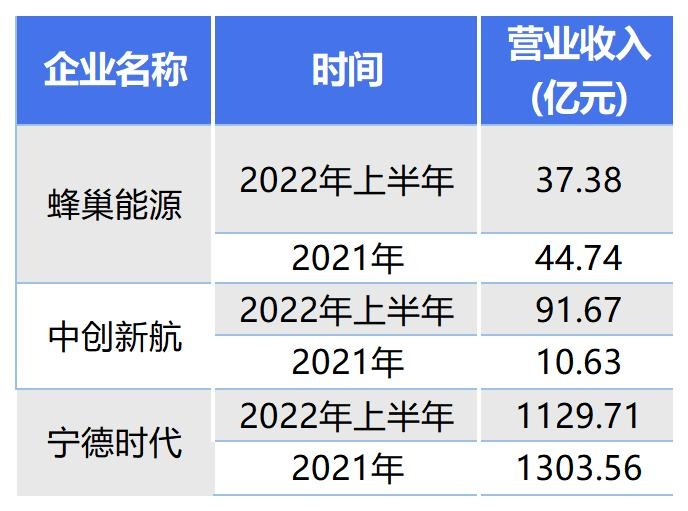
As for the profit margin, Hunan Corun New Energy’s data is detailed. In the first half of the year, the comprehensive gross profit margin was 6.91%, with the battery system gross profit margin of 6.44% and the energy storage system gross profit margin of 32.31%, which is the most profitable project. However, the module level was negative, and the gross profit margin of the cell was only 1.26%, which is not very ideal.
In the first half of the year, Zhongchuang Xinhang’s comprehensive gross profit margin was 8.9%.
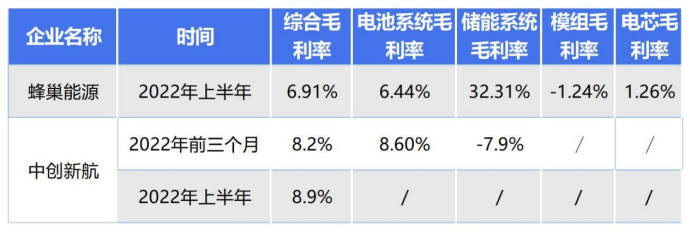 Although the financial report data of CATL (Contemporary Amperex Technology Co., Ltd.) in the first half of the year was not ideal, the overall comprehensive gross profit margin still exceeded that of the two newly listed companies, at 18.68\%. The gross profit margin of power battery systems was 15.04\%, the gross profit margin of energy storage systems was 6.43\%, and the gross profit margin of lithium battery materials was 20.65\%.
Although the financial report data of CATL (Contemporary Amperex Technology Co., Ltd.) in the first half of the year was not ideal, the overall comprehensive gross profit margin still exceeded that of the two newly listed companies, at 18.68\%. The gross profit margin of power battery systems was 15.04\%, the gross profit margin of energy storage systems was 6.43\%, and the gross profit margin of lithium battery materials was 20.65\%.
What’s interesting is that among the three businesses, both CATL and SVOLT have the lowest gross profit margin in the energy storage field, but the energy storage system gross profit margin of NEV (NIO Energy Technology Co., Ltd.) is the highest, even exceeding 30\%.
NEV also provided a comparison of the gross profit margin of other companies’ main business in its prospectus.
It can be seen that NEV’s main business gross profit margin is significantly lower than that of companies such as EVE Energy Co., Ltd. and Guoxuan High-tech Co., Ltd.
Regarding the relatively low gross profit margin of the main business, NEV explained that the main reason is the continuous investment of production lines and some production lines are still in the capacity climbing stage, resulting in higher unit costs. With the rapid growth of the company’s production and sales scale, the scale effect will gradually become apparent. In addition, NEV is also adjusting the prices of some products according to market changes.
In the capacity climbing stage, high unit costs are a normal phenomenon, and similar situations were faced by both CATL and other enterprises such as Funeng Technology and SVOLT in the early stages.
Customer and Sales Information
The development goal of battery companies is to win as many customers as possible.
(1) Customer Information
Currently, NEV has made some gains in the development of domestic and foreign automotive brand customers. In terms of domestic customers, there are mainly whole vehicle enterprises such as Great Wall Motors, Geely Auto, Leapmotor, Dongfeng Motor, Voyah, XPeng Motors, Ideal Auto, Guangzhou Auto, Seres Auto, Hezhong New Energy Auto, and Niu New Energy Auto. As for overseas, NEV has business cooperation with well-known international automakers such as PSA (Stellantis Group).The customers of Zhongchuang Xinhang have already covered enterprises including GAC, XPeng, Changan, Leapmotor, Geely, Hechuang, Dongfeng, Honda, SAIC-GM Wuling, Chery, Ruichi, Dongfeng Xiaokang, and Mercedes-Benz smart.
As for the power battery, CATL’s customer base is very diverse, including enterprises such as Tesla, Hyundai, Ford, Daimler, Great Wall Motors, Ideal, and NIO. In terms of energy storage batteries, CATL has entered into strategic cooperation with major energy enterprises such as State Power Investment Corporation, China Guodian Corporation, China Huadian Corporation, China Three Gorges Corporation, and China Energy Engineering Corporation in China.
Overseas, CATL has conducted in-depth business cooperation with international top ten energy storage demand customers such as Nextera, Fluence, Wartsila, Tesla, and Powin. In addition, CATL also covers areas such as smart mines, battery swapping services, light storage and charge inspection, smart ports, and electric ships.
“The common problem of secondary companies is the high reliance on the top five customers, especially the first largest customer.” As of the first half of this year, for example, Hexagon Energy relied mainly on Great Wall Motors, accounting for over 57%. Similarly, Zhongchuang Xinhang relied heavily on GAC Aion, with the proportion of the top five customers accounting for more than 85% as of the first three months of this year.
In contrast, CATL has a lower dependence on their biggest customer, which is only 10%, and the proportion of their top five big customers is only 31%.
Of course, reducing reliance on Great Wall Motors is also a demand of Hexagon Energy. According to the plan, the proportion of Great Wall’s installed capacity will be reduced to around 50% this year and around 40% next year. There has been a noticeable drop in the first half of this year.
Source: Semi-annual report and prospectus.
Hexagon Energy is trying to move away from the reliance on Great Wall Motors. Currently, in addition to Great Wall, Hexagon Energy has already designated 29 customers and projects.
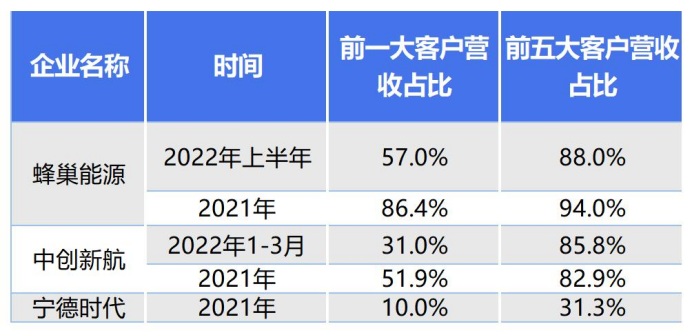
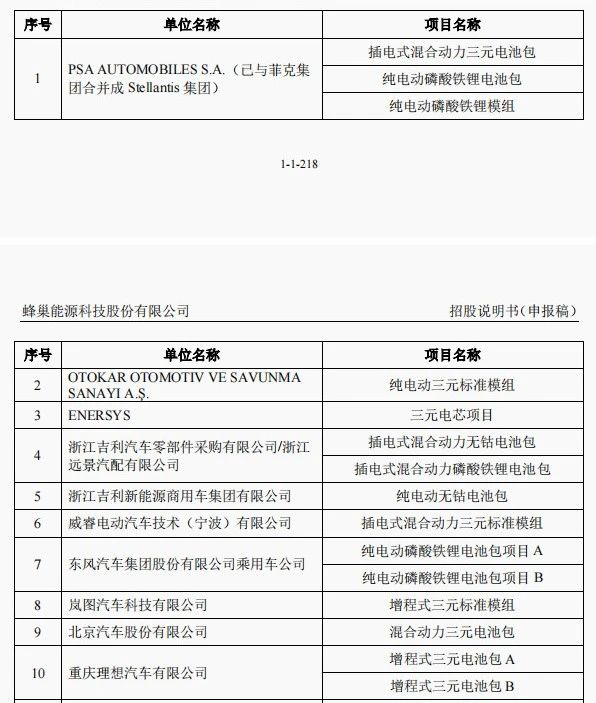
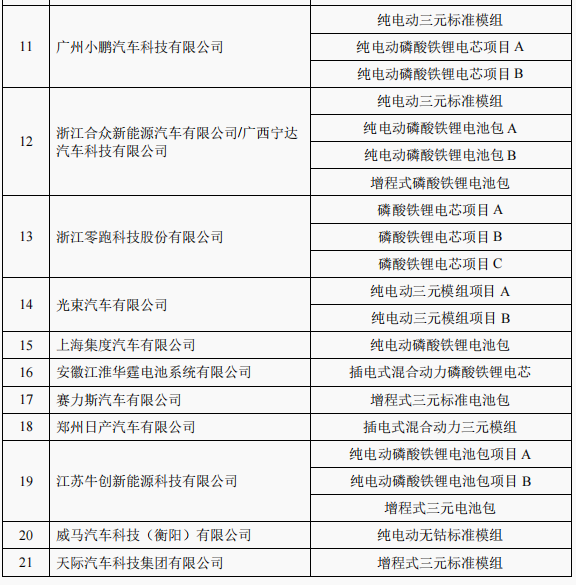
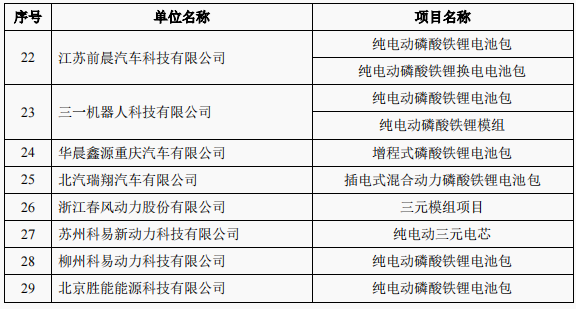
By examining the clients and projects of Hunan Corun New Energy Co., Ltd., it can be found that the company’s customer and product structure is very healthy, with a more balanced distribution of new and old forces, domestic and international car companies, and different types of batteries, including lithium iron phosphate and ternary, and both pure electric and hybrid products. From the perspective of future growth trends, the achievements of Hunan Corun New Energy’s customer and product line layout are worth looking forward to.
2. Production and sales scale
Hunan Corun New Energy is currently behind Contemporary Amperex Technology Limited and CATL in terms of production capacity, with 6.99 GWh, while Contemporary Amperex Technology Limited and Ningde Times New Energy Technology Co., Ltd. have 9.7 GWh and 154.25 GWh, respectively.
However, in terms of sales volume, Hunan Corun New Energy is not far behind Contemporary Amperex Technology Limited, with 3.86 GWh and 4.8 GWh of sales volumes in the first half of the year, respectively. The sales data for Ningde Times New Energy Technology was not disclosed in the semi-annual report, but the installation volume could be used as a reference, which reached 69 GWh in the first half of the year.
For a company that has only been established for four years, the production and sales volume achieved by Hunan Corun New Energy is impressive. For a new company, it is important to focus on both the existing and the growth rate. In this aspect, Hunan Corun New Energy has maintained an expected growth rate.
Research and Development and Patents
Let’s take a look at the “science” content of several companies.
1. Research and development expenses
As a high-end manufacturing industry, batteries require investment in technology research and development to establish a foothold in the market.Using Ningde Times as an example, last year, Ningde Times’ R&D investment reached 7.691 billion CNY, and the number of R&D personnel exceeded 10,000. Although its revenue contribution was not high, accounting for only 5.9%, due to its huge scale, its R&D investment is also overwhelming in the industry.
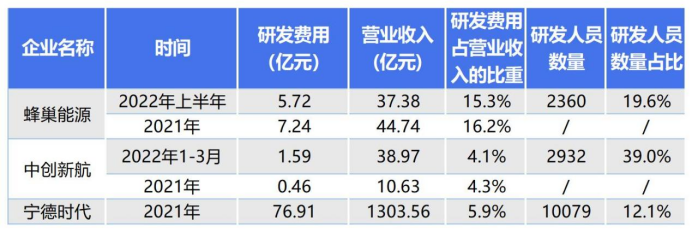
In comparison, the R&D investment of Hesai Energy and TTTech Auto’s Honeycomb Energy and TTTech Auto is much smaller. However, their R&D expenses account for a higher proportion of revenue than TTTech Auto, with a ratio of 15.3% greatly exceeding that of TTTech Auto. Hesai Energy, with revenue of 3.7 billion CNY, invested 570 million CNY in R&D.
Although TTTech Auto has temporarily fallen behind in R&D expenses, it has more personnel than Hesai Energy.
Of course, neither company can compare to Ningde Times in terms of personnel. As of December 31, 2021, Ningde Times had 10,079 R&D technical personnel, including 170 with doctoral degrees and 2086 with master’s degrees.
(2) Patent Situation
As of September 30, 2022, Hesai Energy owned a total of 2,979 domestic authorized patents, including 468 invention patents. According to the public information of the Global Automotive Patent Database of China Automotive Technology and Research Center, Hesai Energy’s power battery patents have been publicly disclosed with 586 patents in 2020, 878 patents in 2021, and 568 patents from January to June 2022.
TTTech Auto has a comprehensive portfolio of over 1,200 patents covering the entire battery industry chain.
As of December 31, 2021, Ningde Times and its subsidiaries owned 3,772 domestic patents and 673 foreign patents, with a total of 5,777 domestic and foreign patents applied for.
From an R&D perspective, it seems that Hesai Energy’s layout is better than TTTech Auto’s. In terms of the number of patents, Hesai Energy follows closely behind Ningde Times, indicating that it attaches great importance to the layout of intellectual property rights. Recently, Hesai Energy has even entered the field of equipment design and production.
Of course, as the industry leader, Ningde Times’ data is certainly much better than that of the two IPO newcomers, which is understandable. This also shows that Hesai Energy’s development in the future is still full of hurdles and challenges.
Key Indicators: Growth and Innovation
Compared with the two “elder brothers” of power batteries, Hesai Energy’s financial data is slightly inferior, but if compared with other companies established for four years, Hesai Energy is undoubtedly “fast”.If the power battery and energy storage battery industry has already become a stable industry, then there is not much room for Honeycomb Energy.
However, on the one hand, this industry is still in a stage of large-scale growth, and compared with stock, it is more important to be faster than growth rate. The growth rate of Honeycomb Energy enables it to stand out in future competition.
On the other hand, battery technology will undergo at least several rounds of technical iterations, each of which may bring about a reshuffle of the industry. With 15.3% of revenue invested in R&D, the young Honeycomb Energy can seize the opportunity of technological change. From the current products of Honeycomb Energy in the areas of stacking technology, cobalt-free batteries, and semi-solid batteries, their innovation is outstanding.
The competition in the battery industry is a long-distance race, and although the start is important, it is more crucial to keep up and speed up in the middle and late stages. Honeycomb Energy has also established a good company organizational structure, which is also a point worthy of recognition.
– END –
This article is a translation by ChatGPT of a Chinese report from 42HOW. If you have any questions about it, please email bd@42how.com.
